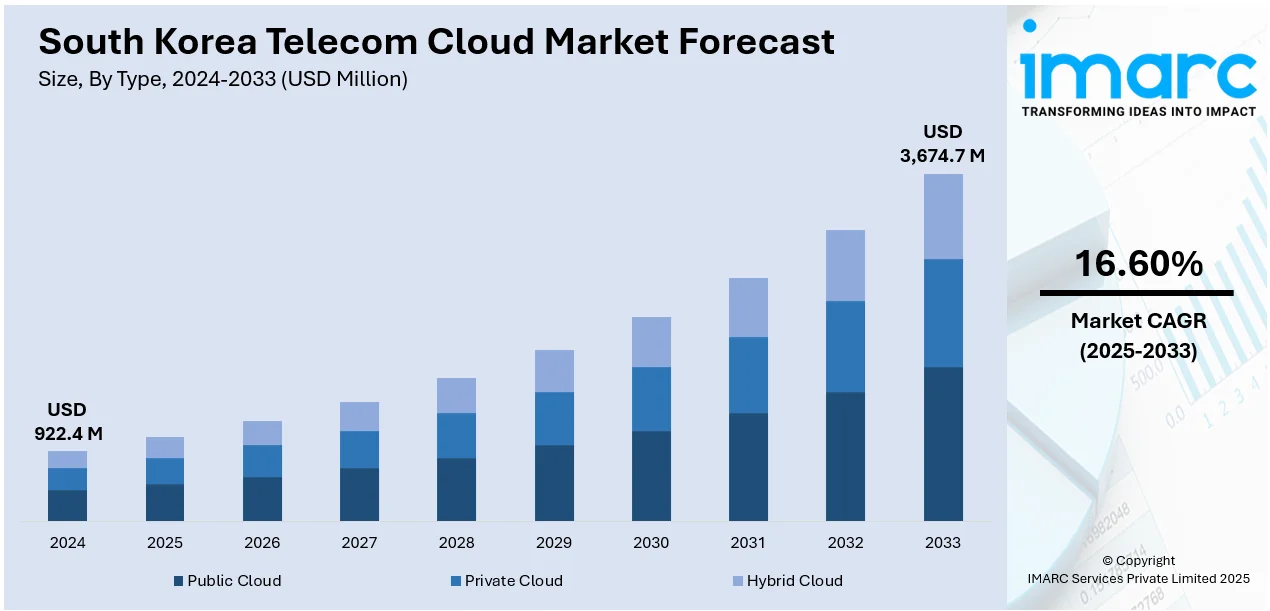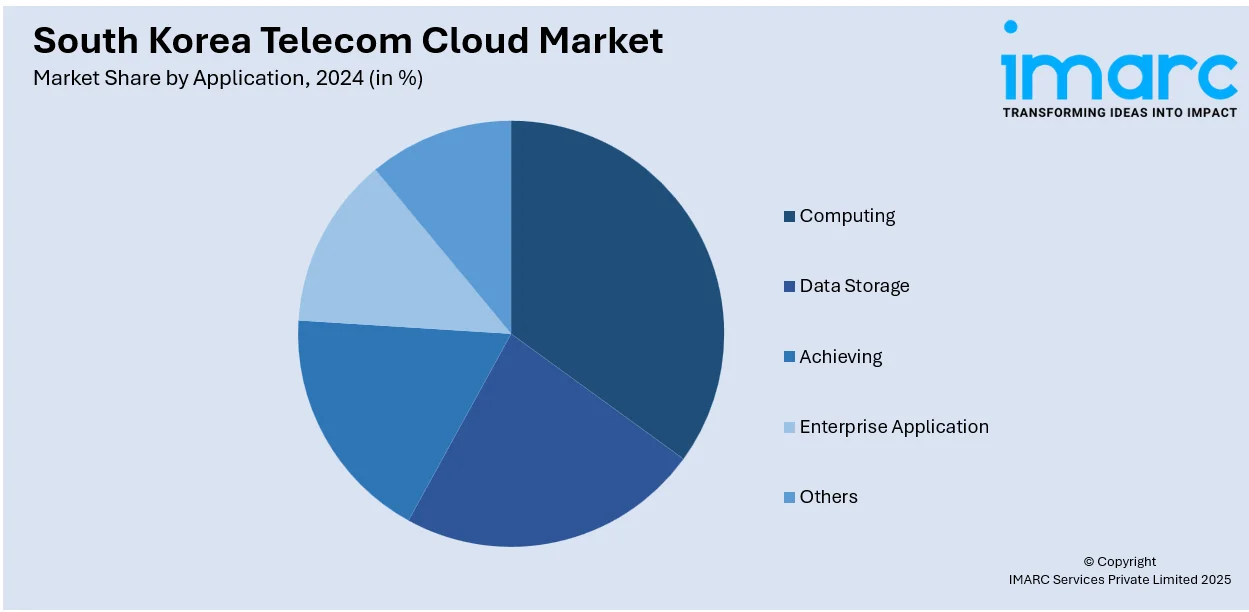
South Korea Telecom Cloud Market Size, Share, Trends and Forecast by Type, Computing Service, Application, End User, and Region, 2025-2033
South Korea Telecom Cloud Market Overview:
The South Korea telecom cloud market size reached USD 922.4 Million in 2024. Looking forward, IMARC Group expects the market to reach USD 3,674.7 Million by 2033, exhibiting a growth rate (CAGR) of 16.60% during 2025-2033. Government digital push, 5G rollout, AI adoption, hyperscaler investments, data privacy laws, smart city projects, increased cloud-native startups, edge computing needs, strong local demand for SaaS, hybrid work culture, IoT expansion, and competitive pricing by domestic and global cloud providers are some of the factors contributing to South Korea telecom cloud market share.
|
Report Attribute
|
Key Statistics
|
|---|---|
|
Base Year
|
2024
|
|
Forecast Years
|
2025-2033
|
|
Historical Years
|
2019-2024
|
| Market Size in 2024 | USD 922.4 Million |
| Market Forecast in 2033 | USD 3,674.7 Million |
| Market Growth Rate 2025-2033 | 16.60% |
South Korea Telecom Cloud Market Trends:
AI Compute Push in Telecom Cloud
South Korea’s telecom cloud sector is seeing stronger support for high-performance AI workloads. A new offering powered by GPUs and run through a local data center is making serious AI computing muscle more accessible to researchers, startups, and businesses. This aligns with the country’s big push to strengthen its standing in global AI development by removing barriers to cutting-edge hardware. With reliable local infrastructure, faster deployment, and growing industry backing, South Korean developers and companies can train, test, and deploy AI solutions more competitively. The push supports the country’s ambition to build an ecosystem where advanced AI services aren’t held back by limited compute power, helping drive fresh ideas and breakthroughs across sectors. These factors are intensifying the South Korea telecom cloud market growth. For example, in August 2024, Lambda partnered with SK Telecom to launch a GPU-powered AI cloud service in South Korea. The service would run through SK Broadband’s Gasan data center, boosting local AI infrastructure for businesses, startups, and researchers. Lambda’s goal is to make advanced AI compute widely available, tapping into South Korea’s fast-growing AI sector with SK Telecom’s support to strengthen the country’s position in the global AI market.

To get more information on this market, Request Sample
Big Bet on Localized AI and Cloud Growth
A major long-term agreement aims to lift South Korea’s AI and cloud capabilities through joint investment and shared expertise. One side commits significant funding to AI, cloud, and IT upgrades, while the other brings global infrastructure and skilled talent to the table. The plan focuses on building tailored AI tools for the Korean market, developing secure domestic cloud offerings, and setting up an AI-focused service provider to speed up adoption across industries. Expanding research and development is central to the push, along with modernizing traditional telecom services into high-value AI and ICT solutions. This move underlines a bigger national push to become a stronger AI player by merging local demand with global tech strength. For instance, in September 2024, KT Corporation and Microsoft signed a five-year multibillion-dollar deal to boost South Korea’s AI and cloud sector. KT would invest in AI, cloud, and IT, while Microsoft would provide infrastructure and talent. The partnership targets customized AI for Korea, sovereign cloud solutions, an AI transformation service company, stronger AI R&D, and KT’s shift toward advanced AI and ICT services.
South Korea Telecom Cloud Market Segmentation:
IMARC Group provides an analysis of the key trends in each segment of the market, along with forecasts at the country and regional levels for 2025-2033. Our report has categorized the market based on type, computing service, application, and end user.
Type Insights:
- Public Cloud
- Private Cloud
- Hybrid Cloud
The report has provided a detailed breakup and analysis of the market based on the type. This includes public cloud, private cloud, and hybrid cloud.
Computing Service Insights:
- SaaS
- IaaS
- PaaS
A detailed breakup and analysis of the market based on the computing service have also been provided in the report. This includes SaaS, IaaS, and PaaS.
Application Insights:

- Computing
- Data Storage
- Achieving
- Enterprise Application
- Others
The report has provided a detailed breakup and analysis of the market based on the application. This includes computing, data storage, achieving, enterprise application, and others.
End User Insights:
- BFSI
- Retail
- Manufacturing
- Transportation and Distribution
- Healthcare
- Government
- Media and Entertainment
- Others
A detailed breakup and analysis of the market based on the end user have also been provided in the report. This includes BFSI, retail, manufacturing, transportation and distribution, healthcare, government, media and entertainment, and others.
Regional Insights:
- Seoul Capital Area
- Yeongnam (Southeastern Region)
- Honam (Southwestern Region)
- Hoseo (Central Region)
- Others
The report has also provided a comprehensive analysis of all the major regional markets, which include Seoul Capital Area, Yeongnam (Southeastern Region), Honam (Southwestern Region), Hoseo (Central Region), and others.
Competitive Landscape:
The market research report has also provided a comprehensive analysis of the competitive landscape. Competitive analysis such as market structure, key player positioning, top winning strategies, competitive dashboard, and company evaluation quadrant has been covered in the report. Also, detailed profiles of all major companies have been provided.
South Korea Telecom Cloud Market News:
- In November 2024, KT Corporation partnered with Databricks to boost data and AI innovation in South Korea. KT would use the Databricks data intelligence platform to build its AI transformation platform, supporting its push into AI and intelligent networks. With deep roots in Korea’s telecom sector, KT aims to strengthen its role in AI and 5G development through this collaboration, driving AI-powered growth and services across the country.
South Korea Telecom Cloud Market Report Coverage:
| Report Features | Details |
|---|---|
| Base Year of the Analysis | 2024 |
| Historical Period | 2019-2024 |
| Forecast Period | 2025-2033 |
| Units | Million USD |
| Scope of the Report |
Exploration of Historical Trends and Market Outlook, Industry Catalysts and Challenges, Segment-Wise Historical and Future Market Assessment:
|
| Types Covered | Public Cloud, Private Cloud, Hybrid Cloud |
| Computing Services Covered | SaaS, IaaS, PaaS |
| Applications Covered | Computing, Data Storage, Achieving, Enterprise Application, Others |
| End Users Covered | BFSI, Retail, Manufacturing, Transportation and Distribution, Healthcare, Government, Media and Entertainment, Others |
| Regions Covered | Seoul Capital Area, Yeongnam (Southeastern Region), Honam (Southwestern Region), Hoseo (Central Region), Others |
| Customization Scope | 10% Free Customization |
| Post-Sale Analyst Support | 10-12 Weeks |
| Delivery Format | PDF and Excel through Email (We can also provide the editable version of the report in PPT/Word format on special request) |
Key Questions Answered in This Report:
- How has the South Korea telecom cloud market performed so far and how will it perform in the coming years?
- What is the breakup of the South Korea telecom cloud market on the basis of type?
- What is the breakup of the South Korea telecom cloud market on the basis of computing service?
- What is the breakup of the South Korea telecom cloud market on the basis of application?
- What is the breakup of the South Korea telecom cloud market on the basis of end user?
- What is the breakup of the South Korea telecom cloud market on the basis of region?
- What are the various stages in the value chain of the South Korea telecom cloud market?
- What are the key driving factors and challenges in the South Korea telecom cloud market?
- What is the structure of the South Korea telecom cloud market and who are the key players?
- What is the degree of competition in the South Korea telecom cloud market?
Key Benefits for Stakeholders:
- IMARC’s industry report offers a comprehensive quantitative analysis of various market segments, historical and current market trends, market forecasts, and dynamics of the South Korea telecom cloud market from 2019-2033.
- The research report provides the latest information on the market drivers, challenges, and opportunities in the South Korea telecom cloud market.
- Porter's five forces analysis assist stakeholders in assessing the impact of new entrants, competitive rivalry, supplier power, buyer power, and the threat of substitution. It helps stakeholders to analyze the level of competition within the South Korea telecom cloud industry and its attractiveness.
- Competitive landscape allows stakeholders to understand their competitive environment and provides an insight into the current positions of key players in the market.
Need more help?
- Speak to our experienced analysts for insights on the current market scenarios.
- Include additional segments and countries to customize the report as per your requirement.
- Gain an unparalleled competitive advantage in your domain by understanding how to utilize the report and positively impacting your operations and revenue.
- For further assistance, please connect with our analysts.
 Request Customization
Request Customization
 Speak to an Analyst
Speak to an Analyst
 Request Brochure
Request Brochure
 Inquire Before Buying
Inquire Before Buying




.webp)




.webp)












